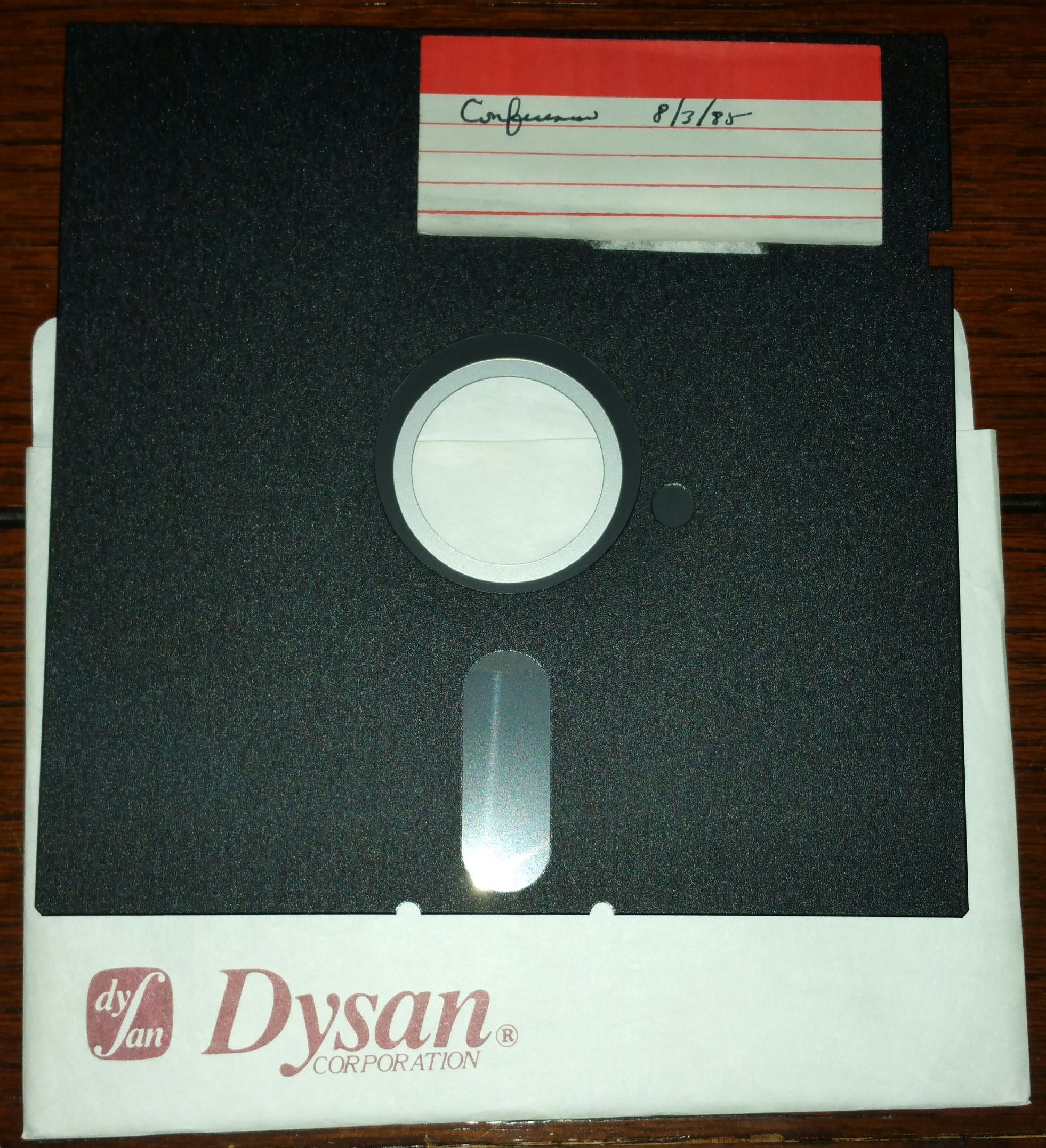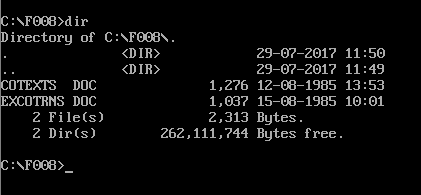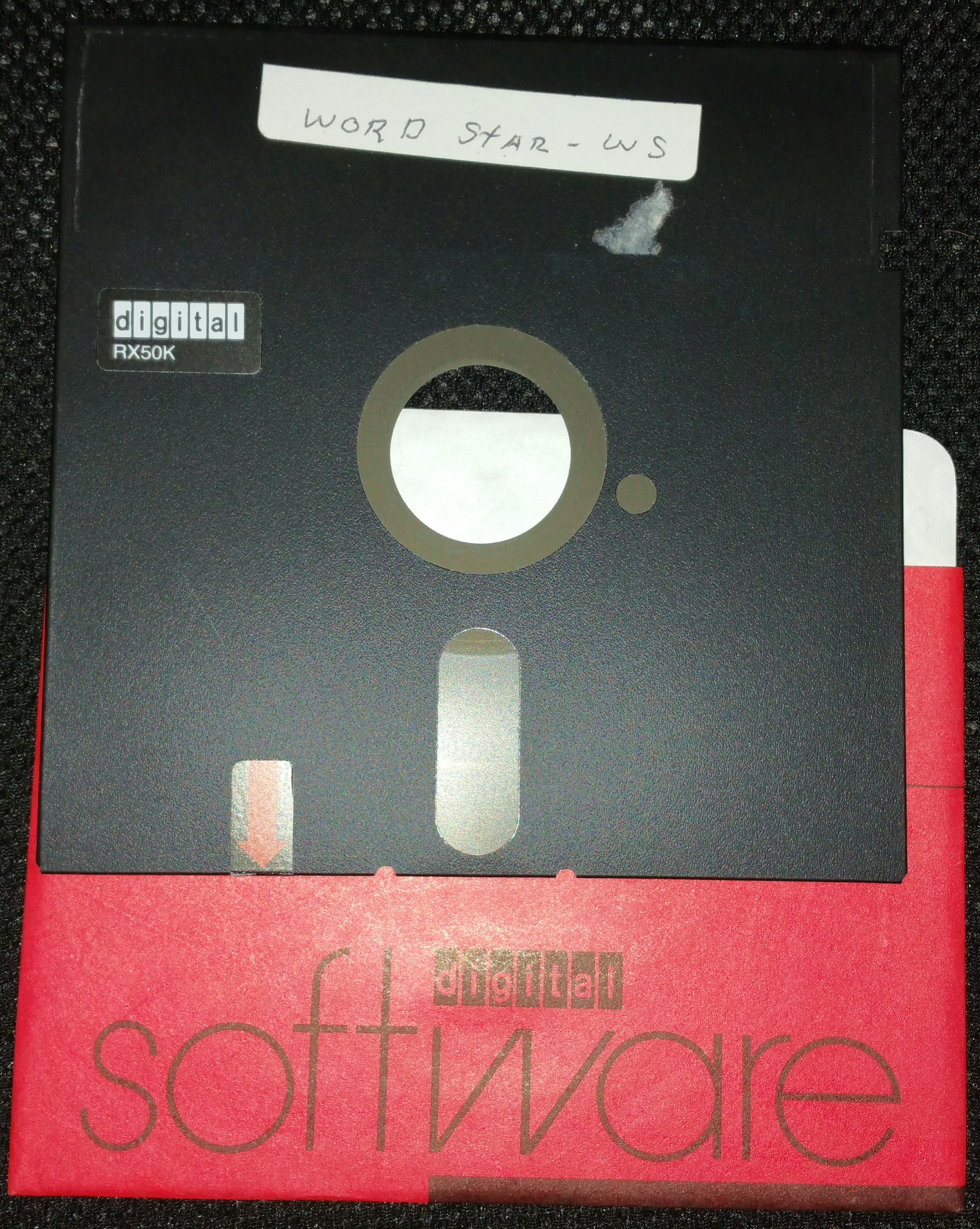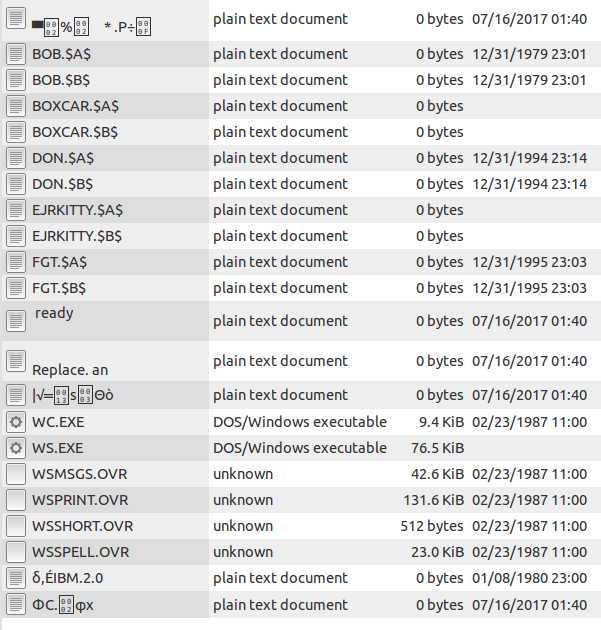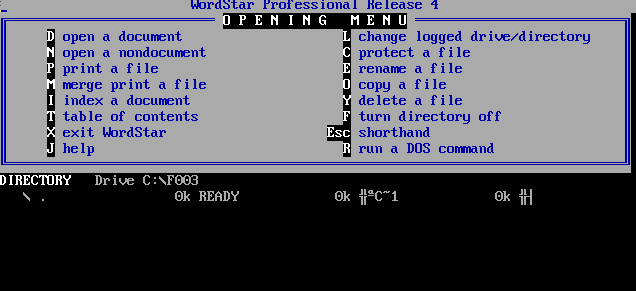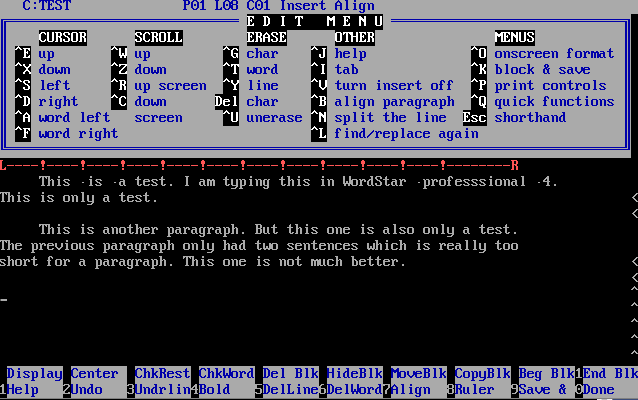Reach Out and Access Someone
(This article is reprinted from the September 6, 1983, issue of ‘The Village
Voice’ and was written by Teresa Carpenter.)
Las Vegas in the rain is about as cheerful as Guam. So last November when the
storms that swamped Malibu swept inland to pound the roof and glass siding of
the Hacienda Hotel, I spent a lot of time curled up under the covers
contemplating the Future.
The Future seemed a pressing issue just then because I was nominally covering
COMDEX, a biannual convention where makers of computer hardware and software
unveil their new lines in an atmosphere of matter-of-fact futurism. The truth
of the matter was that I was a bewildered observer tagging along behind my
spouse equivalent, Steven, who writes a column for ‘Popular Computing’, belongs
to a little cadre of technology writers who cover these events with the espirit
of prospectors in a new gold rush.
One afternoon early in the convention week we went to lunch with another
technology writer from ‘Time’ magazine. The two were swapping industry gossip
when Steven stopped, turned to me, and said, not unkindly, “You can add
something if you like.” That made me so uncomfortable that I didn’t return to
the convention. I strode off as if I had some pressing business to conduct,
played the slots a while, and ended up back at my room burrowed under the
covers to contemplate my place in this new order.
The technological cleft that had been opening between Steven and me went back to
the previous year when we had both gotten Apples for word processing. Buying
the computers was originally my idea. Once we got them home, we both learned
word processing. I learned it faster. But I stopped there, while Steven’s
fascination with the technology impelled him to go further. He fussed with the
computer as if it were a beloved toy. He talked to people, read about
computers, wrote about them, and quietly became a lay expert.
My ignorance was most conspicuous in an area called “telecommunications” – that
is, using the computer to reach and talk to other people. It had not occurred
to me that I might ever want to do that until in perusing the small library in
Steven’s suitcase I came across ‘The Network Nation’, written by a pair of
social theoreticians named Starr Roxanne Hiltz and Murray Turoff. The book,
published in 1978, slightly preceded popular interest in computer technology and
didn’t receive much attention. Yet it contained a fascinating vision. In it
home computers are as common as the telephone. They link person to person,
shrinking, as the authors put it, “time and distance barriers among people, and
between people and information, to near zero.” In its simplest terms, ‘The
Network Nation’ is a place where thoughts are exchanged easily and
democratically, and intellect affords one more personal power than a pleasing
appearance does. Minorities and women compete on equal terms with white males,
and the elderly and handicapped are released from the confines of their
infirmities to skim the electronic terrain as swiftly as anyone else. What the
Network Nation promises is so sensible and humane that it leaves one embarrassed
to be living among contemporaries who take meetings.
��Hiltz and Turoff tended to speak of this society as if it were already a
reality. And it is true that over the past five years hundreds of networks have
spring up pocked by subcultures. There are massive governmental webs to
accommodate the needs of military analysts and artificial intelligence experts.
There are commercial networks like the Source and Compuserve, which sell canned
information and let users talk to one another. There are research and
development networks, which study the way users talk to one another. At the
most rudimentary level there are hundreds of electronic bulletin boards run by
amateur astronomers, gardeners, computer enthusiasts, and Marxists – anyone with
a home computer, one inexpensive piece of software, and a “modem.”
The modem, I knew, was critical to the enterprise. It dials up what is known as
a digital network to put your computer online, in contact with a “host”, a large
computer called a mainframe. As modems are fairly expensive, we got one Hayes
micromodem – a black box about five inches long – which we agreed to share.
From the beginning, however, it had been clear that Steven was Keeper of the
Fire. Having exhibited more initiative, he had laid claim to it. And during
the months after Las Vegas, as I expressed oblique curiosity in the modem, he
protected his prerogatives. He needed it for work.
I should explain that at any time I could have announced I needed the modem and
gotten it. But I didn’t. This passivity was less a result of the
inaccessibility of that black box than my suspicion of it. That I would have to
learn how it worked was inevitable, but to say “I’ll do it today” meant
admitting that some familiar things were on their way to oblivion. By midsummer
I was still at a standoff with the technology in my own home. The modem was not
going to make the first move. I decided that to deal with it, I would have to
whip up some artificial urgency – by writing about it. When I told Steven I
would be needing the modem for work, it sounded so reasonable that he just
shrugged and said, “Sure, call Art Kleiner in the morning.”
Art Kleiner is editor of ‘CoEvolution Quarterly’. More recently he was
recruited to help edit ‘The Whole Earth Software Catalog’, Stewart Brand’s
newest New Age venture. I had found him, on the couple of occasions we had met,
an uncommonly gentle apostle of the New Technology. Long before it was
fashionable, he wrote articles explaining networking to ordinary people. He
seemed a little more realistic than most of the gold rush writers, actually
admitting the possibility that all of this enthusiasm about telecommunications
might be hype.
He was, however, personally passionate about it. As a student at Berkeley in
the late ’70s, he had been mightily impressed by the work of Murray Turoff, who
was operating, under the auspices of the New Jersey Institute of Technology in
Newark, a network called the Electronic Information Exchange System. It was
known to its afficianados as EIES (pronounced “eyes”). Art went on a pilgrimage
to the East Coast to meet Turoff, who gave him a trial account on the system.
Art spent so much time there that he was made a “user consultant” charged with
guiding writers onto EIES.
When I called Art in San Francisco in the middle of July to tell him I wanted an
account on EIES, he uttered a beatific sigh. He would send an electronic
message, a sort of letter of introduction, to Turoff. There would be three or
four days’ wait until I received an account number and password. I would be
billed $75 a month plus connect time that runs between $3 and $8 an hour.
During that waiting period, I began to play around on other systems. Steven had
to make another trip to California, and this time left me not only the modem but
his password on Compuserve and a set of cursory instructions. One evening, I
settled in front of the terminal to make my first solo excursion into the
mystic. I took a floppy disk containing a piece of software called “Z-term,”
slid it into the slot of disk drive A, and closed the door. The computer hummed
and the screen suddenly came alive with glowing green letters. I typed “ZPRO”
to ready the modem to dial. Typed out the number of Telenet. Within the modem
a tiny red light began twinkling to dial the network.
The terrain at the border of Compuserve was more familiar to me than I expected.
I spotted, with relief, the “menu,” which displays a set of choices. I had used
it on earlier occasions when, after Steven had signed on, I would try to pull up
information. Never with very much success. The information services, for all
their taunted diversity, seemed to me cluttered with novelties like biorhythms
and airplane schedules. Steven professed to have run across one pocket of
esoterica which provided the floor plans of Czechoslovakian hospitals. The only
consistently useful data seems to exist for businessmen. Compuserve, which has
about 69,000 subscribers, recently conducted a user survey. More than 96 per
cent of those queried were men, 50 per cent of whom have household incomes of
more than $30,000 a year. This is a comparatively privileged world.
From the menu I selected “Home Services” and entered its number, “1,” after the
waiting prompt, an exclamation point that means the computer and its formidable
resources await your command.
Pressing the return button pulled up a more specific menu, which included news,
weather, sports and – “COMMUNICATIONS.” Entering its number at the prompt, I got
the communications menu, which included “electronic mail.” In this heavily
trafficked feature, users send what resemble teletyped messages to one another’s
electronic mail boxes. More intriguing, however, was option two, the “CB
SIMULATION.”
The simulator is, as the name suggests, a “citizen’s band” on which users across
America and Canada communicate in rapid one-liners fired in succession. The
CBers use handles – Loo Loo and Gandalf and Super Scooper. This sprawling
discourse is conducted with the abandon that anonymity affords. And late at
night these elfish identities convene to chat and play mind games. This
generally occurs on Channel 1 – reserved for “adult conversations.”
I signed on as “Sapphire.” The name had no particular significance, but it
apparently telegraphed something provocative for I was beggared by overtures.
One of these came from Lucky Lori. After the initial stir of a new persona on-
line had died down, she asked if I wanted to join her in private conversation by
entering the “/talk” mode. Lori, who I believe mistakenly took “Sapphire” to be
a variant of “Sappho,” was bisexual. After cordial preliminaries, during which
she confessed to being a little high, she asked if I had ever heard of
“Compusex.” I hadn’t. How is it different from an obscene phone call, I asked.
“More fantasy,” Lori said. But you’re missing sound, I noted. “Written word is
better,” she replied. I signed off on Lori but the following day fidgeted in the
full regret that follows any adventure one declines out of cowardice. A couple
of nights later I got on the board looking for Lori but was promptly hit on by
the Deadwood Kid, who lured me into the private mode. Deadwood was a
blue-collar worker (he said) and a sweet guy. When he asked if I knew about
Compusex, he was so unassuming, I asked him to go on.
Compusex did not unfold quite the same as an obscene phone call, although I
imagine it could have. Deadwood, it turned out, was a sensitive scenarist who
transported us to his living room in Northern California where we danced a while
to Barry Manilow before easing in step toward his bedroom.
It is worth noting that nothing, least of all a seduction, proceeds inexorably
in this medium. Although the CB operates in real time, there is always a couple
of seconds delay between responses, which meant that at one point while
ensconced in an imaginary bed we both claimed to be on top. The encounter was
furthermore plagued by technical interruptions, not the least of which was an
incoming telephone call which knocked me off-line.
The encounter was pretty arousing. Amazing when you consider that it was devoid
of sound, touch, and expression. This strange game illustrated how intimate the
expression of disembodied essences can be.
��
The elves who disport themselves on the channels have created an entire society
on-line. “CBland,” it is explained somewhere on the system, “is a town, a club,
a clique, a fantasy world, a dating service…or anything one wants it to be.”
What Compuserve and the Source apparently didn’t realize when they first put
together their potpourri of consumer goods is that people are not crying for
airline schedules and biorhythms or even stock quotations, but to talk to one
another. The one truly revolutionary thing that telecommunication offers is the
ability to transform time and space between human voices. The possibilities for
twisting the boundaries of conventional communication became clearer when I
finally got on to EIES.
It seemed eerily silent by contrast. Stepping through the menus of the
commercial services is like strolling anonymously through a Turkish bazaar.
Logging on to EIES, however, was like having crossed the threshold of a
monastery where monks, consecrated to the cause of research and development,
glide along the corridors out of reach of the novitiate.
There are about 1200 inhabitants in this little world. It is a neutral host to
groups of scientists, peace activists, executives, philosophers, and others.
Alvin Toffler and former FCC commissioner Nicholas Johnson are among the
notables who have tuned in from time to time to observe various scenarios of
future communication unfold under the ubiquitous guidance of Murray Turoff.
Turoff is known as “the father of computerized conferencing” for an idea that
grew out of work he did in the early ’70s for the Nixon administration. He was
an apolitical eccentric who, after receiving a doctorate in physics from
Brandeis University, had been recruited by a private think tank called the
Institute for Defense Analysis to design systems for playing war games by
computer. Turoff later went to a new operations research group of the Office of
Emergency Preparedness. In his free time there he designged an unauthorized
conferencing system. His superiors, when they discovered the experiment,
threatened to sue him for misuse of government property, but scaled down the
punishment to confiscating his terminal. Turoff regained his terminal and the
upper hand when the administration asked him to dust off his system to implement
the Wage-Price-Freeze Guidelines of 1971.
During the mid-’70s, when he was teaching computer science at the New Jersey
Institute of Technology in Newark, he received a grant from the National
Science Foundation to create an ideal system – one that offers three basic
“modes of interfacing,” or communicating.
��
The simplest to imagine is “electronic mail.” It is like sending a teletype
message. After composing a message in a “scratchpad,” you assign it the user
number of the party to whom it is to be sent, then dispatch it with a keystroke.
The other two formats represent a more radical departure from the conventional
communications. “The notebook” is a workspace where people who are
geographically scattered can co-author or edit manuscripts. Further out on the
fringe is “the conference,” where people can convene and make decisions without
occupying the same space or even the same period of time.
I had learned about these things from ‘The Network Nation’; using them was quite
another matter. Though I had applied myself diligently to the users’ looseleaf
manual sent me by the EIES office in Newark, it was dense with lists of
commands. So arcane is this system, I learned, that *nobody* knows all of the
commands on EIES. I surmised that rather than proceeding logically, I would be
better off just slopping around on the system and working backward from my
mistakes to some guiding principles.
In fumbling about the keyboard trying to compose a plea to Art for help, I
accidentally – and quite inexplicably – opened a conference with myself as
moderator. Sort of like ‘WarGames.’ *More* disturbing was that my wailing
missive – “I am running into brick walls. Cannot seem to contact another human
intelligence” – was posted prominently there as the first entry. This left me
anxious thereafter that my messages might misfire, landing in the box of a
meditating monk.
A few days later, when I was composing in note, another novitiate crash-landed a
one-liner into my scratchpad, “I’m just getting used to this thing! Where are
you?”
Struggling to respond, I discovered the command “???”. I replied, “Lost in
space and time.”
His name was Lee Rhodes and he was production manager for personal computers at
Hewlett-Packard’s plant in Silicon Valley. He was in charge, he said, of
converting the plant to Japanese manufacturing and was on-line to discuss it
with other executives. It was comforting to discover that Lee, who had actually
designed computers, was also having trouble getting the hang of things. But he
was adventuresome and asked if I had used the “link” command. The “link,” as it
suggests, allows two people to converse in one-line thoughts. It is slow going
on EIES – about a 10- to 30-second lag between entries – but is very popular
among new users. The monks, I am told, sniff at newcomers who use a lot of
links. First of all, crashing in on someone’s screen with a link could disturb
their work. More important, however, it represents a shallow attachment to
real-time communication. The sincere telecommunicator will be weaned within a
couple of weeks from dependence upon real time and begin to explore other modes,
where conversation takes place “asynchronously.”
Over the next three weeks, Lee and I moved to a notebook, an abstract domain
that took on the properties of a physical location. We were rarely on-line at
the same time. Whenever he was on, he would post an entry; whenever I was on, I
would post a reply. I learned from this asynchronous exchange that he was
entertaining guests from Europe, had two cats, and had been divorced for four
years. Although he claimed to be maladroit as a writer, he was remarkably
skillful at compensating for the lack of visual and verbal cues. On the CB I
had noticed the elves have developed a clumsy shorthand for the missing cues,
typing “(Blush)” or “(Grin)”. These became annoying because they gave the
exhange the quality of comic book dialogue. Lee, however, was careful to
articulate what pleased or had offended him, the essence of good on-line
etiquette.
The notebook had an unusual effect on time. The conversation took place over
days and weeks, acquiring a longer rhythm than face-to-face encounters. An
entry conveyed more ideas than a spoken utterance. It resembled letter-writing
in this way. But the colloquy was more urgent and continuous than a conventional
correspondence. This asynchronous rhythm becomes even stranger when more than
two people are involved, as they are in the scores of conferences being
conducted at any time on EIES.
��My earlier impression of silence was dispelled once I got within earshot of the
monks clustered and conferring in the alcoves. Some of these gatherings were
public and welcomed anyone. There was the EIES Poetry Corner, where users could
sign in and leave an opus generally signed with a pen name. There were the EIES
News Service and a spot for film critique called the Critics Corner. It was
moderated by a 13-year-old boy who shared an account with his father, a
commodities trader.
Art invited me into two of his own conferences, one for eliciting reviews for
‘The Whole Earth Software Catalog.’ I posted a critique of a program written by
a California proctologist for reading Tarot. The other was a private conference
for magazine writers where the discussion always seemed to return to writing
about technology.
Art once remarked to me, “Studying EIES is like listening to the users of the
first telephone talk about the telephone.” Conversations are often
self-conscious, probably because users are aware of being part of an
experiment. On the one hand the novelty spawns an unnatural enthusiasm. In
trying to overcome the coldness of the medium, some personalities appear manic.
On the other hand the prospect of shooting a message into the void is so awesome
that it can inhibit spontaneity.
I was nervous at first about the prospect of having my own fumbling observed by
some unseen presence. This fear of being watched is fairly common, according to
Turoff and Hiltz. They call it the “fishbowl effect.” For that reason they
tell a new user, as a matter of policy, the types of information that are being
kept for research purposes. Since EIES exists for the purpose of studying the
communication that goes on within its veins, the inner group counts for each
user, the total number of sign-ons, messages sent, and conferences “accessed.”
They do not, they say, keep records of those to whom the messages are sent or
what conferences are accessed. There is a running transcript of virtually all
of one’s exchanges kept within the host computer. You must simply trust that it
will not be read by the programmers.
Beyond anxiety about privacy, the pioneers chatting on EIES are also often
puzzled by the strangeness of the new medium. Conferencing, particularly,
requires a new way of thinking. Its languorous rhythm means that you can not
come on the system at any point and command the entire scope of events. Turoff
and Hiltz have likened this limitation to looking through a peephole into a
giant ballroom: vision is circumscribed by the aperture. One way of surveying
the terrain is to read all the conference entries from beginning to end, but
these sometimes run into hundreds. The better moderators will write summaries
of the proceedings at intervals. A newcomer reading the entries sequentially
may also become frustrated trying to find a line of discussion. Ideas do not
build in a linear fashion. Since no one has to speak in turn, conferees may sign
on and add a reply to a comment that was entered two weeks and ten comments
earlier. That lots of little conversations are going on within the bigger one
means you must learn to read them stereoptically.
��
The fact that it is never anyone’s “turn” to speak creates a sort of populist
chaos. This is, on the one hand, very democratic. “Typical face-to-face
meetings,” explains Elaine Kerr, a sociologist who is head of the EIES user
consultants, “are dominated by men, by people who speak the loudest, by people
with the highest hierarchical positions. But the computer meeting gives women,
and minorities, [those] who are not appropriate to the culture, the opportunity
to voice their opinion.”
EIES recently conducted an experiment where it set 24 groups on-line to work on
a problem – what items does one need to survive in the Arctic? “Right” answers
were provided by Mounties and Eskimos. The EIES groups with more women did
better than those dominated numerically by men. “Now why were they better
decisions, we really don’t know,” says Roxanne Hiltz. “Maybe more of the women
were Girl Scouts.” What the study revealed, however, is that conferencing
leaves women and minorities freer to voice their opinions, and the more
information that gets out, the quantifiably better the decisions to follow.
The potential for telecommunications to blast away social barriers and to get
information circulating among minorities and women has been explored on a small
scale by groups like Community Memory, a group of Berkeley leftists who during
the early ’70s placed terminals in public places. That experiment languished
when the equipment kept breaking down. They are trying to get it going again
and there are presently several pilot projects underway to promote the peace
movement, but these are hampered by the fact that not all of the people who need
to belong on that network have computers.
What was also apparent to me from reading the entries in a couple of social
justice conferences on-line is that they tend to generate rhetoric that meanders
aimlessly in this fluid environment. Those who seem able to direct computer
conferencing most effectively are those who go in for strong leadership. This
is the province of industrialists, about 200 of whom I found on EIES. There are
executives of major American corporations who have been on-line since April to
make recommendations to the White House Conference on Productivity to be held in
Washington in September. One of them, a Xerox vice-president named Paul
Strassmann, was reputed to conduct a mean conference. He agreed to let me look
in as long as I agreed not to publish any of the content. (I had been assured
privately that the transcripts of those discussions, which dealt with measuring
the productivity of information workers, contained no secrets that might topple
the Republic.)
Strassmann, whom I imagined to resemble Jason Robards, did not allow his
conference to turn into, as he described it, “one grand electronic bull
session.” His conferees, who all went through a training session in Houston,
were asked to add only “issues” or “recommendations.” If someone came up with a
particularly good idea, he or she would be appointed an “Issues Manager” charged
with whipping that idea up into a recommendation. Strassmann himself processed
and edited those ideas into “Gutenbergian form,” a xeroxed report that will be
presented to the White House Conference.
When I asked the moderator if he found conferencing satisfactory, he replied:
“I was able to take your message, disassemble it electronically into the Q&A
format and get it back to you in about 20 minutes. In contents, format and
substance it surely beats anything else we could have done.”
��I messaged Paul – on-line one tends to use first names or nicknames, which
creates an illusory intimacy – to tell him that while, yes, we had handled our
interview with dispatch, I sort of missed the old face-to-face approach where a
reporter could seize upon an interesting point and probe. I had already
learned how hard it was to lob hardballs on-line from a little experiment I was
conducting on the side.
I had decided to conduct interviews in my own misconceived conference. I
invited Art Kleiner, then Roxanne Hiltz, Elaine Kerr, Murray Turoff, and others
to answer questions. There were 11 queries dealing with privacy and the quality
of life on-line. Since asking them one by one and waiting for responses could
have taken weeks, I posted them all at once. As a result my sources fluttered
in graciously, like tropical fish nibbling at this or that question, ignoring
the unpleasant ones. After about ten days, my conference was dead. I was not
as quipped as a captain of industry for the rigors of moderating. There are just
some things you have to ask in person.
Art Kleiner offered me his guest quarters, a living room in his San Francisco
apartment. The room, nearly empty except for a pile of quilts and a cot, is a
spartan outpost of the Network Nation. Art is not much into creature comforts.
In one corner of the room, however, was a workspace handsomely appointed with a
KayPro computer, which serves as a nexus of his tasks on EIES and ‘The Whole
Earth Software Catalog.’
Having been separated from my own computer during a three-day business trip
across country, I knew I would have messages waiting. And seeing the KayPro, I
felt an instant urge to log on. Art mused that this was the behavior of a
“communications junkie,” one who comes to depend upon the thrill of finding
response on-line. Art said he knew all about that.
“I was the perfect addict,” he said referring to a period in 1979 when, briefly
out of work, he first found EIES. “I had lots of free time. I was breaking up
with the woman I cared most about. I logged in to escape…and EIES was the
only place that really accepted me at that time.”
Art came to think of EIES, he explained, as a “dreamworld,” where one with
intellect and an antic nature could command a following. “People liked reading
what I wrote,” he said. In person Art has the studied demeanor of an ascetic.
On-line, however, I had found him a much more flamboyant character, zinging
messages full of energy and wry abuse. That pleased him. “Writing well on EIES
is like being good looking. This system is for writers. It’s like being
captain of the football team.”
��
Art’s virtuosity sails at full tilt in a conference called the Soap Opera. This
is where the monks of EIES, including the eminent Murray Turoff, go to play. In
a make-believe village called Disbelief they spin an ongoing yarn, trying on
personae like costumes. Steven, I learned, has been cavorting since January as
“Scoop Frothmouth,” ace reporter for the ‘Disbelief Bugle.’ Art has played as
many as 20 characters of both genders at one time, but appears most frequently
as Starving Artist. Starv has for three years been carrying on a fantasy affair
with a beautiful and willful vamp named Wistful. Her anima is Elaine Kerr, the
on-line sociologist who began consulting for EIES from Columbus, Ohio.
“I got to know Elaine pretty early on,” Art explains. “She is charismatic
on-line. Very dynamic. A petulant and intense character. And very
self-indulgent, which I always find charming in women.”
Art and Elaine have never met, although each sought out the other’s published
picture. Last spring Starv took Wistful on a mythical trip to the Caribbean
where he made love to her in the sand. It was a strange gesture born of events
in the real world. “I was overworked and almost desperate at the time,” Elaine
explains. “So he wrote it in for me. Roxanne understood my delight and the
true nature of this gift, which I can’t begin to convey in a message.”
Elaine recently moved to New Jersey to be physically closer to EIES. When I
returned from California, I sent Murray an electronic message suggesting that
he, Roxanne, Elaine, Scoop, and I all go to dinner. They suggested a French
restaurant in Westfield. Steven confessed to me sometime before we caught the
train that Scoop had once tried to seduce Wistful. This little revelation was
made with impunity since I, having cuckolded him on Compuserve, was in no
position to reproach.
Elaine Kerr was a short dark woman. She was quiet at first, aware perhaps that
we all were familiar with the exploits of the vamp Wistful. But she became
warmer, ebullient in fact, as dinner and two bottles of wine brought everyone’s
fibrillated personae into alignment. Roxanne, who wore an embroidered Victorian
shawl and a gladiola blossom tucked into her dark hair, talked rapidly and
intelligently, sometimes affectionately mocking Murray Turoff, the visionary.
“Murray Turoff says,” she says, “when you build a computer system, you’re
building a social system. Your own social world. It operates the way you like
social worlds to work. And he loves building these social worlds and making
them…watching them work.”
Turoff the Visionary, who sits beside her, is an affable, bearish man wearing a
plaid coat. He had endured himself to me with a message sent some days
earlier. “I am by nature a slow reflective thinker…” he wrote. “Therefore I
assume in face-to-face groups an air of contemplative wisdom to disguise my slow
wit. On-line, of course, I have no such problem since instant response is not
required. You might say I created this medium to satisfy my own needs.”
“She’s not kidding,” Murray intones to the gathering around the table. “…I’m
designing a human social system.”
“You could design a dictatorship as well,” interjects Elaine.
��”I’d love to do it,” Murray muses in the abstract. “All I need is the right
company. Some companies operate under a feudal system. If I was doing a
dictatorship, first of all, you couldn’t send a message> to anyone unless I
first approved the message. Okay? If we had voting, I’d get 10 votes to your
one. And I would have access to your files. Now you can imagine that I could
see that to some managers.”
“We presented this to one very large corporation,” Roxanne continues. “The
Dictator Design, tongue in cheek. And they said, ‘That sounds wonderful. We’ll
take it.’ And on the other hand, when I gave them the results of [the
experiments] which showed them that this medium freed women to make equal
contributions, they said, ‘We don’t want that.'”
I was incredulous. “Sure,” Murray replied. To Murray the construction of
worlds is an intriguing game. He regards the alternatives with dispassionate
curiosity. Roxanne is the social conscience of the two. Unlike Murray, she
believes that the behavior of people determines the design of social systems.
The Network Nation, he explains, should not be a sprawling, comprehensive,
homogenous system. Rather, it should be a collection of hundreds or thousands
of smaller systems, “intentional communities” for purposes as varied as
political debate and a big game of bridge. Keep things small so they can be
controlled by the groups that operate them. People should be able to design the
way they want to live and also stand guard over their own data bases.
“I think we both believe,” she says, “that the most desirable communities for
telecommunications are like electronic small towns. They number in the
thousands, not in the tens of thousands. What happens on something like EIES
with only 1200 people total is that everyone can know someone or know of someone
who knows them. There are only three programmers. Those three could get [into
files] but they have ties with a lot of users. The community ties are such that
[there are] social pressures to treat each other with dignity. It works.”
What if the CIA came around asking for a private message?
“There will be a fire,” says Roxanne resolutely. “There will be a fire.”
When the first bottle of wine came, I proposed a toast to the Network Nation.
That was a presumptuous thing to do. I really didn’t have the credentials, but
on the tide of such heady debate, one feels expansive. One feels exclusive. One
certainly feels relieved not to be caught without a modem on the cusp of a new
age. In the end, it could all come to nothing, but who wants to be left on the
outside?
“To the Network Nation,” I said and everyone clinked glasses. “May it grow,
prosper, and remain democratic,” Roxanne replied.
